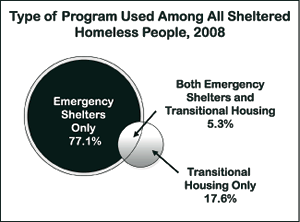October 2009
In this Issue
Research-Oriented Leadership Welcomed
Analysts Reveal Housing Inventory Changes
Updating the National Perspective on Homelessness
HomeBase Focuses on Homelessness Prevention
In the next issue of ResearchWorks
Updating the National Perspective on Homelessness
HUD recently released The 2008 Annual Homeless Assessment Report to Congress. This report, the first in the series to provide year-to-year trend data, documents the nature and extent of homelessness in the United States. For this national study of homelessness, HUD employed two measures:
- Point-in-time snapshots that account for both sheltered and unsheltered homeless persons on a single night, usually at the end of January, and that reveal trends about the seasonality of homelessness.
- Over time counts, using Homeless Management Information Systems (HMIS), which provide more detailed information on those who access a shelter over the course of a full year. In this report, 222 local communities contributed HMIS data to produce a national estimate of sheltered homeless.
 HUD's assessment concludes that overall homelessness
in America held steady from October 1, 2007 to
September 30, 2008, although shifts occurred in those
requiring services and where they were located. During
that period, approximately 1.6 million people used
shelters or transitional housing — 5,200 (0.3%) more
than in the previous year. The number of sheltered
homeless individuals also remained virtually the same,
although the number of homeless families seeking
shelter increased by 9 percent overall and by nearly
56 percent in suburban and rural areas. Two-thirds
of shelter seekers were individuals, while one-third
were with children. Sixty-two percent were members
of minorities, and 64 percent were male. The majority
(40%) was 31 to 51 years of age, and 12 percent were
veterans.
HUD's assessment concludes that overall homelessness
in America held steady from October 1, 2007 to
September 30, 2008, although shifts occurred in those
requiring services and where they were located. During
that period, approximately 1.6 million people used
shelters or transitional housing — 5,200 (0.3%) more
than in the previous year. The number of sheltered
homeless individuals also remained virtually the same,
although the number of homeless families seeking
shelter increased by 9 percent overall and by nearly
56 percent in suburban and rural areas. Two-thirds
of shelter seekers were individuals, while one-third
were with children. Sixty-two percent were members
of minorities, and 64 percent were male. The majority
(40%) was 31 to 51 years of age, and 12 percent were
veterans.
The changing patterns of homelessness between 2007 and 2008 also indicate how the economic crisis may be affecting homelessness in America. For example, many more homeless persons are entering the shelter system directly from homes — after wearing out their welcome with family and friends or coming from stable living arrangements where they lived for a year or more.
Other findings include:
- On a single night in January 2008, approximately 664,000 individuals (either sheltered or unsheltered) were homeless, down about 7,500 people (or 1%) from the previous year.
- The heaviest concentrations of homeless people in shelters and on the street continued to be in urban areas. One in five people homeless on a single night in January were located in Los Angeles, New York, and Detroit.
- The number of people accessing residential programs in suburban and rural areas increased substantially, from 23 percent in 2007 to 32 percent in 2008.

With its release of this report, HUD also began to measure homelessness on a quarterly basis, beginning with point-in-time data from January 2009 and HMIS data from the first quarter of the year. This project will help researchers better understand the impact of the current economic crisis on homelessness and track real-time changes. For this first assessment, data were gathered from a cross-section of nine rural, suburban, urban, and mixed jurisdiction localities and presented in The Homelessness Pulse Project: First Quarterly Report. The original nine, Phoenix/Mesa/Maricopa County, Arizona; Bridgeport/Stratford/Fairfield, Connecticut; the District of Columbia; Lakeland/Winterhaven/Polk County, Florida; the Kentucky Balance of State; Shreveport/Bossier/Northwest Louisiana; New York City, New York; Cleveland/Cuyahoga County, Ohio; and the counties of Richmond/Henrico, Chesterfield, and Hanover in Virginia, will expand to include more COCs.
This first survey reports only a fraction of what the Pulse Project will eventually reflect: reporting on new clients each quarter; breaking down the homeless population into individuals and families and by type of shelter use (emergency or transitional); and detailing household types, prior living arrangements, and the stability of those arrangements. The reports will be enhanced with accounts by the COCs about their experiences, such as the observation by a shelter manager in Louisiana regarding the absence of families entering shelter during the January point-in-time count and by a Virginia case manager who noted an increase in the number of new clients.
More information from the most recent studies of homelessness is reported in HUD's recently published The 2008 Annual Homeless Assessment Report to Congress and The Homelessness Pulse Project: First Quarterly Report, both of which are available as free downloads from HUD's Homelessness Resource Exchange at www.hudhre.info/documents/4thHomelessAssessmentReport.pdf and www.hudhre.info/documents/HomelessnessPulseProjectJul09.pdf, respectively.

